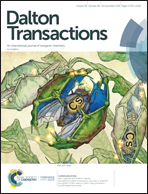Isomeric Ir(iii) complexes for tracking mitochondrial pH fluctuations and inducing mitochondrial dysfunction during photodynamic therapy†
Abstract
Mitochondrial pH is known to be alkaline (near 8.0) and has emerged as a potential factor for mitochondrial function and disorder. Here we investigate two pairs of isomeric phosphorescent Ir(III) complexes (1–4) that show mitochondrial pH-responsive properties and induce mitochondrial dysfunction during photodynamic therapy. These complexes are designed to function by controlling the protonation of the benzimidazole and carboxyl groups. 1 and 2 exhibit enhanced emission intensity and a blue-shift emission change in response to pH alterations from 6.0 to 8.0. They have ideal pKa values (7.49 for 1 and 7.41 for 2) and show mitochondria-specific phosphorescence staining in situ, thereby allowing the monitoring of mitochondrial pH in live cells. 3 and 4 produce abundant intracellular ROS and exhibit high phototoxicities against cancer cells. Interestingly, these pH-responsive probes can be utilized to monitor the change in mitochondrial pH and mitochondrial damage during photodynamic therapy (PDT), which provides a convenient method for the in situ monitoring of therapeutic effects and the assessment of treatment outcomes.



 Please wait while we load your content...
Please wait while we load your content...